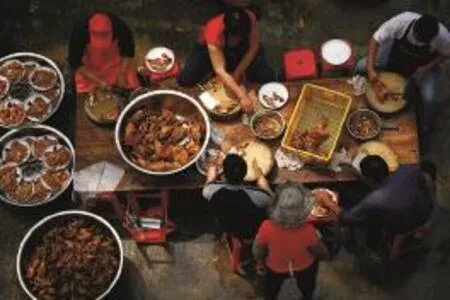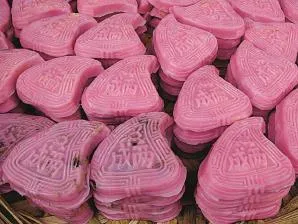以福为食
2016-05-17LanXiaojiang,BianJiajin,Yishan等
以福为食

It's just the beginning of twelfth lunar month, but many Lingnan people have started to prepare foods for the Spring Festival.In this region, people especially treasure the new year and the luck it supposedly brings, so dishes presented for the Spring Festival require some good expression to bring good luck.

Commerce and trade in Guangdong has a long history of development, Cantonese therefore emphasise “wealth” a lot.Thus, on the tables of the Spring Festival all over China, Guangdong may be one of the areas that are most particular about the expression of luck.At the transition from the old to the new, preparing some foods with good wishes to expect fortune in the new year becomes the most important activity in Cantonese households.
Most of the foods worth being taken onto table are often specially named to make others more inviting to other people.For example, the pronunciation of tangerine and “auspicious”in Chinese are homophonic, as are “make a fortune” and hair weeds, “getting a promotion”and rice cake.They are all the must-haves for the festival.In Guangzhou, even if the rice cake is not intended to be eaten, it still shows up on the table in the hope of good luck.The radish in Cantonese is also pronounced “Cai Tou”, named after its homophony “Cai(wealth)”.Having radish cakes in the Spring Festival then means bringing in more wealth and treasure.
If a lucky name is not easy to think up, Lingnan people will seek good meanings in the shapes of foods, such as fried Jau Gok.The shape of Jau Gok and a purse, or wallet, are alike.In the past, Cantonese, regardless of the poor or the rich, will always fry Jau Gok on the Spring Festival's Eve to wish that the next year would be like the oily bright fi red Jau Gok, rich and af fl uent.In the Chaozhou-Shantou region, the Shu-ke cake with Chinese characters “Fortune”, “Longevity” and “Lucky”on them, which look similar to peach shaped cakes, are also necessary snacks.
Some of these auspicious courses for the festivals must be started several months in advance, but people just enjoy it.The housewife makes the best festival meals would make her household very proud, so is worth the effort.In many villages, people also serve open-air banquets and perform dragon parades to produce a lively and joyful atmosphere and to make the whole village more auspicious.
People add their expectation of wealth and fortune into the food, and they also ritualise the process of making and enjoying these foods as way of welcoming good luck.
刚入腊月,很多岭南人已经开始准备过年的美食。在这个重视传统节日,又以﹃饮饮食食﹄出名的地区,能端得上春节饭桌的美食,除了比平常菜肴凝聚更多的时间、技巧和心力,还需要特别带来福气的寓意。
广东地区商贸历史悠久,广东人尤其看重“财运”。所以,在中国各地春节食桌上,广东大概是最讲究食物“彩头”的地区之一。在新旧交替的年节时分,准备一些有好意头的食物,求得来年的好运,成了广东人家最重要的事情之一。
能端上新年饭桌的食物,大多有个好名字,使人更乐意享用。比方说名字的谐音通“吉”的金橘,谐音通“发财”的发菜,谐音通“年年高升”的年糕,都是必备的美食。在广东,过年时的年糕,就算不吃,也要在家里摆上一块,图好意头。 萝卜广州方言称“菜头”,取“菜”与“财”的谐音,过年食萝卜糕,也寓意招财进宝。
如果名称上不好找意头,岭南人就会在形状上找吉祥。比方,广州人过年都要炸油角。油角的形状像荷包,即钱包。以前的广州人,不管富家还是穷人,到了岁晚,总要开油镬炸油角,寓意来年的日子,像油光发亮的油角一样,油油润润、富富足足。潮汕地区的鼠壳粿形状像寿桃,粿面上印有“福”“寿”“大吉”等字样,成为年节必备的小吃。而用来制作阳江炒米饼的饼模上面,也刻满了祥禽瑞兽,福禄平安的画样。
这些年节吉祥菜,有些要提前好几个月准备,但人们却对此乐此不疲。谁家的主妇把年菜准备得丰富又精致,谁家的年也会过得更有面子。很多村子里,还会大摆流水宴席,请来舞狮队,增加热闹、欢愉的气氛,他们相信这会让整个村庄都更“旺”。
人们把对财富、运气的期盼都放在食物里,也把制作、享用食物的过程,当作迎接福气的仪式。

DONGGUAN SUGAR RING
东莞糖环
In Dongguan, families made the sugar ring with sticky rice and granulated sugar, cut out the ring with knives, and deep fry it in oil.As the sugar ring has a colour similar to gold, before the Chinese New Year, Dongguan households will prepare sugar rings as snacks for visitors to enjoy.

NANXIONG PRESSED SALTED DUCK
南雄板鸭
The most famous local product of Nanxiong must be its pressed salted duck, i.e.preserved duck.People in Nanxiong often start making preserved duck two months before the Lunar New Year.Nanxiong, which lies in the north of Guangdong, experiences huge daily temperature swings and cold, frosty weather, which adds to the fl avour of Nanxiong pressed salted duck.
CHAOZHOU-SHANTOU SHU-KE CAKE
潮汕鼠壳粿
Shu-ke cake has been an important cuisine for the Chinese New Year in the Chaozhou-Shantou region.Three or Four days before the New Year, families will make the cake with dry pulsatilla plant they collect, and sticky rice fl our.The cake is often shaped as a peach and inscribed with lucky Chinese
words like “fu” (luck), “shou” (long life), or “da-ji” (auspice).


GUANGDONG PRESERVED MEAT AND SAUSAGES
广式腊味
It has been a tradition for Guangdong people to eat preserved meat and sausages with rice in the New Year.Normally, the meat and sausages are made in the fi rst month of the Lunar calendar.In the past, even preserved meat and sausages were once-a-year delicacies.Guangdong preserved meat and sausages have kept its traditional taste while embracing other practices.During the Tang and Song dynasties, Arabians and Indians would bring Guangdong sausages and preserved meats to their hometowns.
GUANGDONG NEW YEAR RICE CAKE
广式年糕
The New Year rice cake has been a well-known traditional food in the province for a long time.Having a similar pronunciation as “nian-gao” (making progress every year), it becomes the must-have for Guangdong families during the Chinese New Year.Containing brown sugar, the traditional food has a dark orange colour and soft texture.In Guangdong, households will cut the cake into pieces and stir-fry it.
FORTUNE FROM FOOD
Text by Lan Xiaojiang Translations by Bian Jiajin&Yishan Photos by CFP

